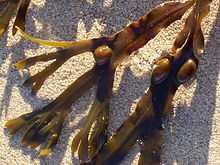Fucus vesiculosus
| Fucus vesiculosus | |
|---|---|
 | |
| Scientific classification | |
| Kingdom: | Chromalveolata |
| Phylum: | Heterokontophyta |
| Class: | Phaeophyceae |
| Order: | Fucales |
| Family: | Fucaceae |
| Genus: | Fucus |
| Species: | F. vesiculosus |
| Binomial name | |
| Fucus vesiculosus L. | |

Fucus vesiculosus, known by the common name bladder wrack or bladderwrack, is a seaweed found on the coasts of the North Sea, the western Baltic Sea, and the Atlantic and Pacific Oceans, also known by the common names black tang, rockweed, bladder fucus, sea oak, black tany, cut weed, dyers fucus, red fucus, and rock wrack. It was the original source of iodine, discovered in 1811, and was used extensively to treat goitre, a swelling of the thyroid gland related to iodine deficiency.
Description
The fronds of F. vesiculosus have a prominent midrib and almost spherical air bladders which are usually paired but may be absent in young plants. The margin is smooth and the frond is dichotomously branched. It is sometimes confused with Fucus spiralis with which it hybridises.[1]
Distribution
Fucus vesiculosus is the most common algae on the shores of the British Isles.[2] It has been recorded from the Atlantic shores of Europe, Northern Russia, the Baltic Sea, Greenland, Azores, Canary Islands, Morocco and Madeira.[3][4] It is also found on the Atlantic coast of North America from Ellesmere Island, Hudson Bay to North Carolina.[5]
Ecology
The species is especially common on sheltered shores from the middle littoral to lower intertidal levels.[5] It is rare on exposed shores where any specimens may be short, stunted and without the air vesicles.[6] F. vesiculosus supports few colonial organisms but provides a canopy and shelter for the tube worm Spirorbis spirorbis, herbivorous isopods, such as Idotea and surface grazing snails such as Littorina obtusata.[1] Phlorotannins in Fucus vesiculosus act as chemical defences against the marine herbivorous snail Littorina littorea.[7] Nevertheless, galactolipids, rather than phlorotannins, act as herbivore deterrents in this species against the sea urchin Arbacia punctulata.[8] Methyl-jasmonate may induce the phlorotannins production.[9] Fucophlorethol A is a type of phlorotannin found in F. vesiculosus.[10]
Biology
Plants of F. vesiculosus are dioecious. Gametes are generally released into the seawater under calm conditions and the eggs are fertilised externally to produce a zygote.[1] Eggs are fertilised shortly after being released from the receptacle. A study on the coast of Maine showed that there was 100% fertilisation at both exposed and sheltered sites.[1] Continuously submerged populations in the Baltic Sea are very responsive to turbulent conditions. High fertilisation success is achieved because the gametes are only released when water velocities are low.[11]
Consumption
Primary chemical constituents of this organism include mucilage, algin, mannitol, beta-carotene, zeaxanthin, iodine, bromine, potassium, volatile oils, and many other minerals.
Some people may suffer an allergic reaction to the iodine in bladder wrack.[12]
See also
References
- ↑ 1.0 1.1 1.2 1.3 Nicola White (2008). "Bladder wrack – Fucus vesiculosus". Marine Life Information Network. Retrieved December 13, 2013.
- ↑ F. G. Hardy & M. D. Guiry (2003). A Check-list and Atlas of the Seaweeds of Britain and Ireland. London: British Phycological Society. ISBN 0-9527115-1-6.
- ↑ M. D. Guiry & Wendy Guiry (January 12, 2007). "Fucus vesiculosus Linnaeus". AlgaeBase. National University of Ireland, Galway. Retrieved April 22, 2012.
- ↑ Charlotta A. Nygård & Matthew J. Dring (2008). "Influence of salinity, temperature, dissolved inorganic carbon and nutrient concentration on the photosynthesis and growth of Fucus vesiculosus from the Baltic an Irish Seas". European Journal of Phycology 43 (3): 253–262. doi:10.1080/09670260802172627.
- ↑ 5.0 5.1 W. R. Taylor (1957). Marine Algae of the Northeastern Coast of North America. University of Michigan, Ann Arbor. ISBN 0-472-04904-6.
- ↑ C. S. Lobban & P. J. Harrison (1994). Seaweed Ecology and Physiology. Cambridge University Press, Cambridge. ISBN 0-521-40897-0.
- ↑ J. A. Geiselman & O. J. McConnell (1981). "Polyphenols in brown algae Fucus vesiculosus and Ascophyllum nodosum: chemical defenses against the marine herbivorous snail, Littorina littorea". Journal of Chemical Ecology 7 (6): 1115–1133. doi:10.1007/BF00987632.
- ↑ Michael S. Deal, Mark E. Hay, Dean Wilson & William Fenical (2003). "Galactolipids rather than phlorotannins as herbivore deterrents in the brown seaweed Fucus vesiculosus". Oecologia 136 (1): 107–114. doi:10.1007/s00442-003-1242-3.
- ↑ Thomas M. Arnold, Nancy M. Targett, Christopher E. Tanner, Walter I. Hatch & Kirstin E. Ferrari (2001). "Evidence for methyl jasmonate-induced phlorotannin production in Fucus vesiculosus (Phaeophyceae)". Journal of Phycology 37 (6): 1026–1029. doi:10.1046/j.1529-8817.2001.01130.x.
- ↑ Sabine Parys, Stefan Kehraus, Anja Krick, Karl-Werner Glombitza, Shmuel Carmeli, Karin Klimo, Clarissa Gerhäuser & Gabriele M. König (2010). "In vitro chemopreventive potential of fucophlorethols from the brown alga Fucus vesiculosus L. by anti-oxidant activity and inhibition of selected cytochrome P450 enzymes". Phytochemistry 71 (2–3): 221–229. doi:10.1016/j.phytochem.2009.10.020.
- ↑ E. A. Serrao, G. Pearson, L. Kautsky & S. H. Brawley (1996). "Successful external fertilization in turbulent environments". Proceedings of the National Academy of Sciences 93 (11): 5286–5290. Bibcode:1996PNAS...93.5286S. doi:10.1073/pnas.93.11.5286. PMC 39237. PMID 11607682.
- ↑ "Bladderwrack". MedlinePlus. National Institutes of Health. Retrieved December 13, 2013.
External links
| External identifiers for Fucus vesiculosus | |
|---|---|
| Encyclopedia of Life | 893114 |
| ITIS | 11335 |
| NCBI | 49266 |
| WoRMS | 145548 |
| Also found in: Wikispecies, MarLIN, AlgaeBase | |
 Media related to Fucus vesiculosus at Wikimedia Commons
Media related to Fucus vesiculosus at Wikimedia Commons- F. Bunker. "Fucus vesiculosus Linnaeus Le Jolis". British Isles Seaweed Images.
- M. D. Guiry. "Fucus vesiculosus Linnaeus". North Atlantic Seaweeds.
- "Bladder wrack (Fucus vesiculosus)". ARKive.